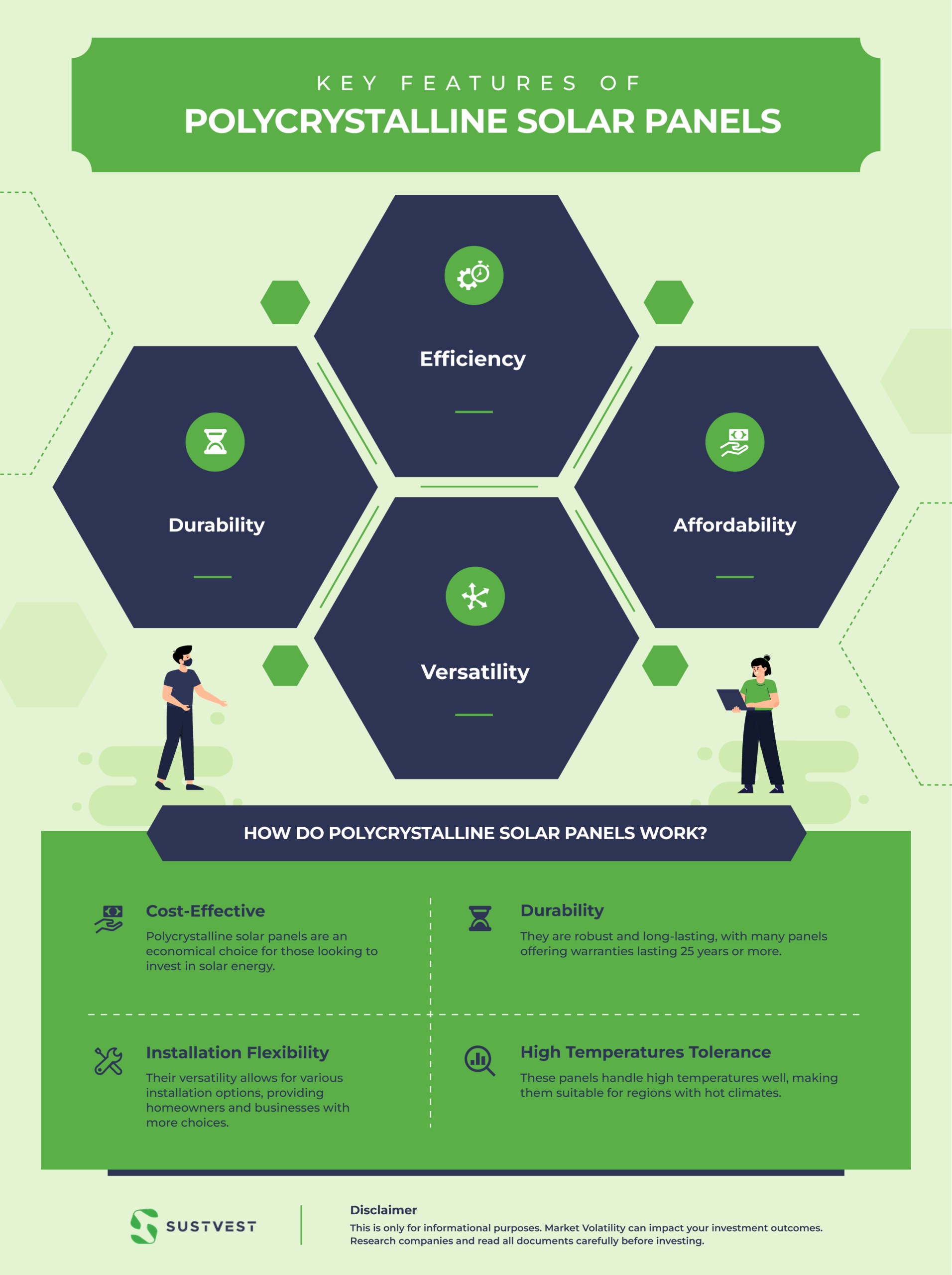What are Polycrystalline Solar Panels?
Polycrystalline sun-powered chargers, frequently alluded to as polycrystalline sun based modules, are a famous decision for outfitting sun-oriented energy. These boards are developed utilizing numerous silicon gems, and they offer a few benefits that make them a favored decision for both private and business sun-oriented establishments visit sustvest.

Understanding Polycrystalline Solar Panels
Polycrystalline sunlight-based chargers, otherwise called polycrystalline sunlight-based chargers, are a kind of photovoltaic module that involves numerous silicon gems. These gems are less unadulterated than the ones found in monocrystalline boards, and they are softened and projected into square or rectangular molds, bringing about a particular appearance portrayed by a mosaic of various shades of blue.
Polycrystalline sunlight-powered chargers, otherwise called polycrystalline sunlight-powered chargers, are a kind of photovoltaic module that has acquired critical ubiquity in the environmentally friendly power market. One of the characterizing highlights of these boards is their exceptional appearance. At the point when you take a gander at a polycrystalline board, you’ll see a mosaic-like theme of various silicon precious stones. This unmistakable look is a consequence of the assembling system used to make them.
Key Features of Polycrystalline Solar Panels
1. Efficiency: Polycrystalline sunlight-based chargers are known for their expense viability. While they might have a somewhat lower proficiency contrasted with monocrystalline boards, they offer superb incentives for cash.
2. Durability: These boards are profoundly solid and can endure different weather patterns, making them reasonable for a large number of utilizations.
3. Affordability: Polycrystalline boards are more reasonable than monocrystalline ones, making them a financial plan accommodating choice for those hoping to embrace sunlight-based power.
4. Versatility: They can be introduced on roofs, in ground-mounted clusters, and, surprisingly, in sunlight-based ranches, making them a flexible decision for the sun-powered energy age.

How Do Polycrystalline Solar Panels Work?
Polycrystalline sun powered chargers use the photovoltaic impact to change over daylight into power. At the point when daylight raises a ruckus around town gems inside the board, it makes an electric flow. This current is then captured and converted into usable electricity, which can power homes, businesses, and more.
Advantages of Polycrystalline Solar Panels
1. Cost-Effective: Polycrystalline solar panels are an economical choice for those looking to invest in solar energy.
2. Durability: They are robust and long-lasting, with many panels offering warranties lasting 25 years or more.
3. High Temperatures Tolerance: These panels handle high temperatures well, making them suitable for regions with hot climates.
4. Installation Flexibility: Their versatility allows for various installation options, providing homeowners and businesses with more choices.
Considerations When Choosing Polycrystalline Solar Panels
1. Efficiency: While slightly less efficient than monocrystalline panels, it’s essential to assess your energy needs and budget to determine if the efficiency difference matters for your specific application.
2. Space Availability: Polycrystalline panels may require more space due to their lower efficiency, so consider your available space when choosing them.
3. Aesthetics: Some homeowners may prefer the appearance of monocrystalline panels, so aesthetic considerations could be a factor.
FAQs
Q1. What does a solar panel look like?
A sunlight-powered charger commonly seems to be a level, rectangular, or square-formed gadget comprising a few more modest, equitably divided photovoltaic cells or modules. These cells are normally encased in a casing made of metal or another solid material, which is much of the time anodized aluminum. The front surface of the board is covered with a straightforward and strong material, typically safety glass, to shield the phones from the components while permitting daylight to go through.
Q2. What is the advantages and disadvantages of Solar Panels?
| Advantages | Disadvantages |
| 1. Sustainable power Source: Sun-powered chargers tackle energy from the sun, which is a practically boundless and sustainable asset. However long the sun sparkles, sun-powered chargers can create power, decreasing dependence on petroleum products. | 1. High Initial Cost: The upfront cost of purchasing and installing solar panels can be significant. While costs have been decreasing, it may still take several years to recoup the investment through energy savings. |
| 2. Reduces Electricity Bills: By generating your electricity, solar panels can significantly reduce or even eliminate your monthly electricity bills. Excess energy can often be sold back to the grid. | 2. Intermittent Energy Production: Solar panels only generate electricity when the sun is shining. Energy storage solutions like batteries can help address this issue, but they add to the overall system cost. |
| 3. Environmentally Friendly: Solar energy production produces little to no greenhouse gas emissions, contributing to a cleaner environment and mitigating climate change. | 3. Space Requirement: Solar panels require a considerable amount of space, either on rooftops or in dedicated ground-mounted installations. This may not be feasible for every property. |
| 4. Low Operating Costs: Once installed, solar panels have minimal operating and maintenance costs. Regular cleaning and occasional inspections are typically all that’s needed to keep them running efficiently. | 4. Weather Dependency: Solar panels are affected by weather conditions. Cloudy days and shading from trees or buildings can reduce energy production. |
| 5. Energy Independence: Solar panels provide a degree of energy independence, reducing vulnerability to energy price fluctuations and supply disruptions. | 5. Aesthetic Impact: Some people find the appearance of solar panels on rooftops unattractive, and homeowners’ associations or local regulations may impose restrictions on their installation. |
| 6. Motivating forces and Duty Credits: Numerous states offer impetuses, tax reductions, and discounts to energize the establishment of sun powered chargers, making them more reasonable for property holders and organizations. | 6. Environmental Impact: The production and disposal of solar panels can have environmental impacts, including the use of certain materials and energy-intensive manufacturing processes. |
| 7. Expanded Property Value: Sunlight based chargers can build the resale worth of a property, making it more appealing to likely purchasers. | 7. Installation Complexity: Proper installation of solar panels requires expertise to ensure efficiency and safety. Poorly installed systems may not perform optimally. |
Q3. What is a polycrystalline solar cell?
In synopsis, sunlight powered chargers offer various advantages, including clean energy age, cost reserve funds, and ecological benefits. Be that as it may, they likewise accompany specific difficulties, like high introductory expenses and irregular energy creation. Concluding whether sunlight-based chargers are a reasonable choice relies upon individual conditions, including area, spending plan, and energy needs.
Q4. What are the types of Solar Panels?
A polycrystalline sun-based cell, frequently alluded to as a polycrystalline sun-powered photovoltaic cell, is a sort of sun-oriented cell used to change over daylight into power. It is a vital part of polycrystalline sunlight-powered chargers. These sunlight-based cells are produced using semiconductor materials, commonly silicon, yet they vary from monocrystalline sun-powered cells in their gem construction and assembling process.
Q5. Which type of Solar Panel is best?
Efficiency: If you have restricted rooftop space or need to expand the power yield from a little region, monocrystalline boards are commonly the most effective decision. They have a higher energy change rate than different sorts.
Cost-Effectiveness: Polycrystalline boards are in many cases more practical than monocrystalline boards. In the event that you’re working with a strict spending plan, they might be the better decision.
Space Accessibility: Think about the accessible space for your sun-based establishment. Dainty film boards can be favorable when you have adequate space or need adaptable establishment choices, while monocrystalline or polycrystalline boards are better for restricted space.
Aesthetics: On the off chance that the presence of your sun-powered chargers is a critical concern, monocrystalline boards are frequently viewed as more tastefully satisfying because of their uniform dark tone.
Durability: Polycrystalline boards are known for their solidness and protection from brutal weather patterns, making them appropriate for areas with outrageous environments.
Natural Effect: Slender film sun-powered chargers commonly have a lower natural effect during assembling, yet they might have more limited life expectancies and lower proficiency.
Application: Consider the specific application. For residential rooftop installations, monocrystalline or polycrystalline panels are common choices. Thin-film panels may be suitable for larger-scale commercial or utility projects.
Climate: The climate of your location can influence your choice. Some panel types perform better in hot or humid climates, while others are more suited for colder regions.
Budget: Your budget is a critical factor. Monocrystalline panels tend to be more expensive but also more efficient, while polycrystalline and thin-film panels are more budget-friendly.
Warranty and Manufacturer: Research the warranties and reputations of solar panel manufacturers. A longer warranty and a reliable manufacturer can provide peace of mind regarding the panel’s performance and longevity.
Conclusion – Harnessing Solar Power with Polycrystalline Solar Panels
All in all, polycrystalline sunlight-based chargers, frequently alluded to as polycrystalline sunlight-based chargers, offer a savvy and dependable method for saddling sun-oriented energy. Their strength, reasonableness, and flexibility make them a convincing decision for private and business-oriented establishments. While they might have marginally lower effectiveness contrasted with monocrystalline boards, their various benefits make them a well-known choice for those hoping to embrace sustainable power and diminish their carbon impression.
While considering sunlight-powered charger choices, it’s pivotal to assess your particular requirements, accessible space, and financial plan to decide if polycrystalline sunlight-based chargers are an ideal choice for you visit sustvest.

Founder of Sustvest
Hardik completed his B.Tech from BITS Pilani. Keeping the current global scenario, the growth of renewable energy in mind, and people looking for investment opportunities in mind he founded SustVest ( formerly, Solar Grid X ) in 2018. This venture led him to achieve the ‘Emerging Fintech Talent of the Year in MENA region ‘ in October 2019.




